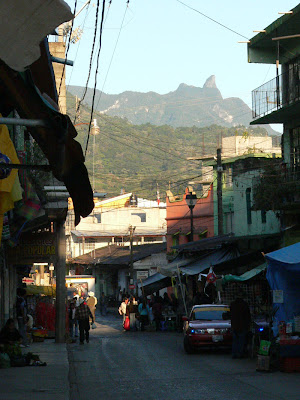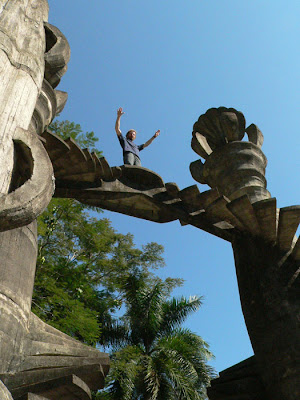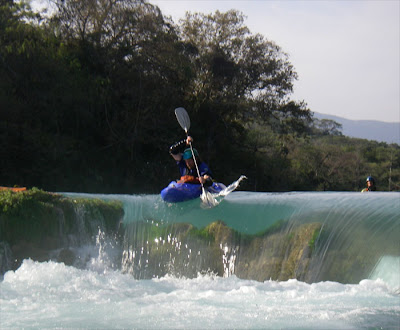
Micos Put-inLooking for sunshine in the wet and cold winter months? Want to paddle some warm water and run fun waterfalls? Check out some Mexican culture far away from tourists? Enjoy great hospitality and authentic Mexican food? Don’t want to worry about shuttling logistics or about convincing an airline attendant to check in your boat as skis? Make your way to the Huasteca region in San Luis Potosi and let Leland and Andria of
Brushy Mountain Publishing and the
Huasteca Secreta (HS) staff take care of the details! This was our first all-arranged paddling trip and it has set rather high standards and expectations for future ones.
 Huasteca Secreta at Salto El Meco
Huasteca Secreta at Salto El Meco Our Room with a View
Our Room with a View USV - The Ultimate Shuttle Vehicle
USV - The Ultimate Shuttle VehicleTo my great disappointment I was not able to paddle due to a shoulder injury, but the culture tour Juan and Jimena from HS arranged especially for me made up for it. Lucky Pete got to eat the cake and keep it too… He paddled all the rivers and joined me for artsy explorations.
Day 1 - Ojo FrioI didn’t paddle, but according to Pete this is a very fun run with tons (about one hundred as Pete said) of ledges, small falls and boofs. It’s in the middle of sugar cane fields and very small Mexican villages. The Ojo Frois is actually a tributary of the Rio Gallinas (see Tamul Falls, day 4).

 Day 2 - Micos Section of Rio Valles
Day 2 - Micos Section of Rio Valles200+ ft/mile run consisting of the 7 super fun waterfalls. Beautiful drops over travertine rock terraces. Waterfalls as paddler-friendly as they can get: simple approaches and big and calm landing pools. Best of all, there was some action for me, too! The falls can be jumped and the pools swum. Lucky coincidence: just as our group put in, a local family jumped of the first falls, among them, two girls aged 10 or 12. I found the practical demonstration much more convincing than Juani’s and Leland’s assurance that this is a common local activity. Juani displays great paddling skills – this is his third river run ever. Or is it a sign how friendly the falls are? At the takeout, every paddlers dream: the bar is set up, dinner served right at the take-out and the HS staff loads up all the boats!
 Falls #1: Leland showing how its done and Claudia taking a good look
Falls #1: Leland showing how its done and Claudia taking a good look Doing it without a kayak
Doing it without a kayak Andria running #2
Andria running #2 Juani sliding #3
Juani sliding #3 Pete on #4
Pete on #4 Matt running the tallest #5
Matt running the tallest #5 Group below #6
Group below #6 Day 3 - Culture Tour
Day 3 - Culture TourPete and I are off on a culture tour with Jimena and Jorge, our driver. First stop were the newly excavated ruins of Tamtoc. No big pyramids like the ones in the Yucatan. But a number of nice sculptures, the largest calendar stone (depicting a ritual sacrifice that took place every 53 years) and a statue of the chief – foot to waist – in the buff.
 The calendar stone
The calendar stoneAfter driving another hour or so, we end up on a side road high in the limestone mountains. Jimena finds a little boy who leads us up through the forest to a 60 meter wide gaping hole of Sótano de las Huahuas, a 200 meter deep limestone pit cave. After the sun sets, birds (actually not swallows but swifts) start circling directly above us and make their kamikaze dive to their sleeping places deep in the cave. We sit directly under the flyway of tens of thousands of birds that rush by in waves with great noise and whooshing of their wings. The amazing spectacle lasts for about half an hour until dark. For unknown reason we left our headlamps in the car, but make good progress in the moonlight and with Jimena’s little keychain light.
 Sótano de las Huahuas
Sótano de las HuahuasWe drive on to Xilitla our final destination of the day. During dinner at open windows we watch bustling night life in the town square. Here we also see a family of three Gringo tourists – the only ones we saw on this trip (except us).
Day 4 - Culture Tour continuedBefore breakfast we go for a little stroll through Xilitla. It’s perched on top of a limestone ridge and makes the impression of an authentic Mexican city: narrow busy streets with merchants opening their stores, rows of colorful houses, shouting newspaper boys, laundry flapping in the wind, flowers and noisy birds.






On to the next cultural point: Las Pozas, the surrealistic architectural garden in the semi-tropical rainforest by Sir Edward James. James was a British patron of surrealistic artists and rather surrealist himself. We take an hour to wander through the enchanted forest and discover new fantastical creations around every corner.





For lunch we reunite with the others in the largest city of the area Cd. Valles. One of the river runners experienced unfortunate back problems on yesterdays El Salto run necessitating a hospital visit to check out the problem. But he rejoins us for our trip to the HS resort at Tamul falls. Here Rio Gallinas drops over hundred meters into the Santa Maria (which is called Tampaon further downstream). Everywhere one looks from the HS bungalow high on the ridge no signs of human activities, untouched forested mountains, and deep below the majestic falls. Sitting on the terrace with a Corona in hand and watching the falls darken in the disappearing sunlight we are probably the only witnesses to this spectacle.


 Day 5 - Back to the Micos
Day 5 - Back to the MicosMore dropping and jumping of waterfalls. A funny episode: three paddlers show up with first generation playboats (RPM, Supersport). The somewhat nervous woman boater asks her trip leader how to run the falls: “Just paddle over the falls and lean back.”, he replies. After watching our group running the falls, she turns to him and said, “But they’re all leaning forward!?” The leader replies, “Hmmph, you will have to ask Leland about that”, and of he goes, penciling in old-school-style with arms and paddle high over his head. Bar and snacks at the take-out. Fantastic dinner at a terrace at the lip of the Salto des Mecos falls above the resort.
 Matt, Lisa, John, Juani, Ricardo, Kemper and Karen styling Micos #4Day 6 – El Salto section of Rio Valles
Matt, Lisa, John, Juani, Ricardo, Kemper and Karen styling Micos #4Day 6 – El Salto section of Rio VallesThe group paddles the El Salto for the second time, Pete’s first run. He reports three more exciting drops: El Nemo, a smaller one that ends in a mandatory boof over a hole, La Luminosa, and El Salto. The most scenic drop is the Aquarium.
 Andria and Leland at El Nemo
Andria and Leland at El Nemo
 Dooley showing us how to fly a canoe
Dooley showing us how to fly a canoe Kemper taking a look at the Aquarium
Kemper taking a look at the Aquarium
Not being able to follow the group on the river, I join Juani senior, Juani junior and Jimena checking out the (dry) falls just upstream of the put-in. We run into a wedding photo shoot and the falls begin to flow! Nice surprise. I also get some good shots of Juani and Jimena jumping of a cliff – higher than any of the Micos drops and into totally green water. The good-bye dinner takes place at the HS beach – excellent food as every evening surrounded by candles and with music all night.
A few general observations:
Food is just amazing - don’t expect to loose weight. Be prepared to be waited on hand and foot (although this may change once HS are in regular operation). Huasteca roads are bad and driving takes for ever, come with patience. If you are on your own, a basic knowledge of Spanish is necessary to travel in this area.







































